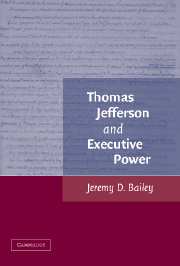Book contents
- Frontmatter
- Contents
- List of Figures and Table
- Preface
- Acknowledgments
- Abbreviations
- 1 “The execution of laws is more important than the making of them”: Reconciling Executive Power with Democracy
- 2 Executive Power and the Virginia Executive
- 3 Executive Power and the Constitution of 1787
- 4 “To place before mankind the common sense of the subject”: Declarations of Principle
- 5 The Real Revolution of 1800: Jefferson's Transformation of the Inaugural Address
- 6 To “produce a union of the powers of the whole”: Jefferson's Transformation of the Appointment and Removal Powers
- 7 The Louisiana Purchase
- 8 To “complete their entire union of opinion”: The Twelfth Amendment as Amendment to End All Amendments
- 9 “To bring their wills to a point of union and effect”: Declarations and Presidential Speech
- Development and Difficulties
- Index
5 - The Real Revolution of 1800: Jefferson's Transformation of the Inaugural Address
Published online by Cambridge University Press: 24 July 2009
- Frontmatter
- Contents
- List of Figures and Table
- Preface
- Acknowledgments
- Abbreviations
- 1 “The execution of laws is more important than the making of them”: Reconciling Executive Power with Democracy
- 2 Executive Power and the Virginia Executive
- 3 Executive Power and the Constitution of 1787
- 4 “To place before mankind the common sense of the subject”: Declarations of Principle
- 5 The Real Revolution of 1800: Jefferson's Transformation of the Inaugural Address
- 6 To “produce a union of the powers of the whole”: Jefferson's Transformation of the Appointment and Removal Powers
- 7 The Louisiana Purchase
- 8 To “complete their entire union of opinion”: The Twelfth Amendment as Amendment to End All Amendments
- 9 “To bring their wills to a point of union and effect”: Declarations and Presidential Speech
- Development and Difficulties
- Index
Summary
Of his own election in 1800, Thomas Jefferson famously said, it “was as real a revolution in the principles of our government as that of 1776 was in its form.” By this interpretation, the partisan contest of 1800 was the culmination of the disputes of the 1790s in that it was as much a contest over the meaning of the new Constitution as a fight over who would rule. When, as he put it, the “mighty wave of public opinion” had rolled, Jefferson's Republican Party was proven to be the people's party, just as the Revolution of 1776 had declared the people's opposition to England's form of government. “The nation declared its will by dismissing functionaries of one principle, and electing those of another.” As certain as he was that there were two parties in nature, and that one party was for the people and the other against the people, Jefferson believed the Revolution of 1800 was a victory for a reading of the Constitution that would be more favorable to popular government.
Central to this transformation of executive power was changing the form of the inaugural address in order to meet the educative requirement of democratic leadership. Although democratic government is government by the majority will, majorities are comprised of citizens who need to have those very principles explained to them.
- Type
- Chapter
- Information
- Thomas Jefferson and Executive Power , pp. 132 - 150Publisher: Cambridge University PressPrint publication year: 2007



